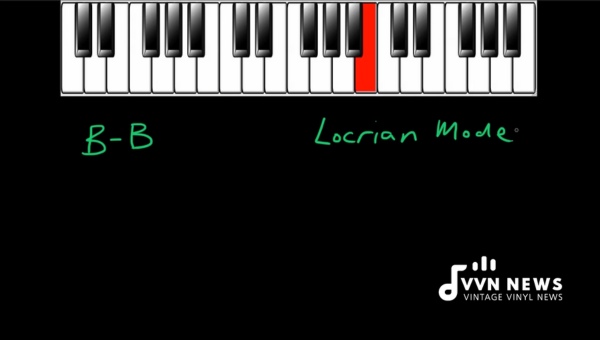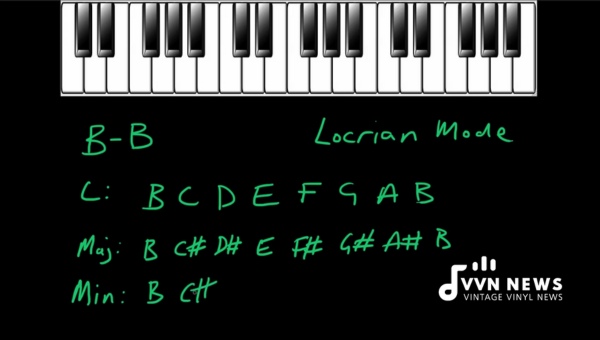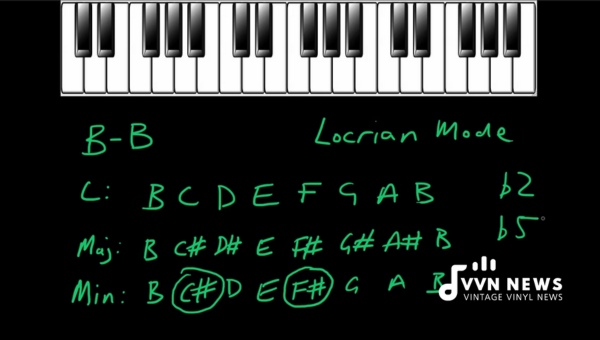The locrian mode holds a somewhat mysterious place in the world of music theory.
Often overlooked due to its dark and unresolved sound, this mode rewards the curious musician with its unique character and unconventional beauty.
The Locrian is the seventh mode of the major scale, starting and ending on the seventh degree.
Its distinctiveness lies in its flat second and a flat fifth, creating an unusual tonality that can evoke an array of moods from haunting to introspective.
Whether you’re just beginning to explore musical modes or seeking new ways to spice up your compositions, gaining insight into this rare gem can open up a world of possibilities.
Join me as we unfold the enigmatic qualities of the Locrian mode and discover how composers have used it to create some truly captivating pieces of music.
What is the Locrian Mode in Music?
The Locrian mode stands as the seventh mode of the diatonic major scale, emanating an intense and somewhat dissonant vibe.
Within this mode lies a tonally unique scale defined by its first degree (the tonic) and its flatted fifth, which together give rise to the distinctive tritone interval – a sound often associated with tension.
Due to its less-than-harmonious nature, this mode is infrequently employed as a central tonality in compositions, yet when used adeptly, it imparts an unmistakable atmosphere.
The Locrian’s uneasy resonance steers creators toward innovative harmonic landscapes.
How is the Locrian Mode Structured?

The Locrian mode has a distinctive formula that sets it apart from other modes. To construct it, one starts with a major scale and then lowers both the second and fifth scale degrees by a half step.
Additionally, the third, sixth, and seventh degrees are also flattened. This yields a sequence of intervals: half step, whole step, half step, whole step, whole step, whole step.
When applied from C natural as the root note, the Locrian mode would look like this:
- C (root)
- Db (flat 2nd)
- Eb (flat 3rd)
- F (perfect 4th)
- Gb (flat 5th) – creating a defining tritone interval from the root
- Ab (flat 6th)
- Bb (flat 7th)
Notably, it’s the only mode where the tonic chord is diminished due to its flat five.
This quality gives the Locrian its intriguing tension and its standing as an outlier among musical modes.
Also Read: E Flat Minor Blues Scale [Infuse Your Tunes With Moody Blues]
What Are the Scale Degrees of the Locrian Mode?
The Locrian mode manifests as an intriguing sequence of intervals.
Starting on the seventh degree of a major scale, its complexion is characterized by a sequence that reads whole, half, whole, whole, half, whole, whole (W-H-W-W-H-W-W).
When you position the notes relative to a standard major scale, the Locrian mode surfaces with these specific intervals:
- Tonic (1st Degree) – This is your starting note and forms the root of the Locrian mode.
- Flat Second (♭2nd Degree) – Immediately it introduces a sense of tension compared to the major scale with its lowered second degree.
- Flat Third (♭3rd Degree) – A minor third augments this tension and sets a distinctly minor quality from early on.
- Perfect Fourth (4th Degree) – This slight step towards stability is short-lived within the unique soundscape of this mode.
- Flat Fifth (♭5th Degree) – The defining element; it creates a diminished fifth or tritone from the tonic note.
- Flat Sixth (♭6th Degree) – The tale continues with yet another flattened interval contributing to the mode’s haunting palette.
- Flat Seventh (♭7th Degree) – Completing our journey just shy of an octave higher than we began.
Unveiling these scales on your instrument necessitates both precision and familiarity with their distinctive sound profile – echoing mystery and tension in equal parts.
How Can You Play the Locrian Scale on Various Instruments?

The Locrian scale is intriguing and can impart an air of mystery to your music on various instruments.
Whether your instrument of choice is a piano, guitar, or wind instrument, mastering this mode will give your compositions a distinctive sound.
On Piano
To play the Locrian scale on the piano, begin at B natural to stay within the C major scale for simplicity.
Start with the seventh note and ascend by playing each white key until you reach the next B.
Ensure to emphasize the half steps from B to C and from E to F, as these intervals define its sound.
Also Read: Musical Modes Explained [What Are They & How Do I Use Them?]
On Guitar
For guitarists, fingering patterns are invaluable. To create a B Locrian scale pattern, start on the low E string at the seventh fret.
Remember that the formula for creating a Locrian scale involves starting from the seventh degree of a major scale and playing a sequence of whole and half steps: H-W-W-H-W-W-W (H represents half step, W represents whole step).
On Wind Instruments
Wind musicians must focus on breath control when approaching scales with unusual intervals like this one.
For example, on a flute or saxophone in C tuning, play from B to C (half step), then continue ascending in whole and half-step increments that follow the Locrian pattern.
No matter your instrument, integrating this unique mode into your practice routine can enrich your musical vocabulary immensely.
Variations of the Locrian Mode
Within the realm of the Locrian mode, variations exist that alter its sonic characteristics.
One noteworthy variant is the Locrian ♮2 (natural 2), which replaces the flat second degree with a natural second.
This subtle change softens the mode’s dissonance, providing a slightly more consonant sound while retaining the eerie essence of Locrian.
Another variation is Locrian #6 (sharp 6), where the flat sixth degree is raised to a natural sixth.
This adjustment creates an augmented second interval between the fifth and sixth degrees, imparting an exotic flavor to melodies and harmonies.
Each variation offers distinct harmonic textures:
- Locrian ♮2:
- 1 – ♮2 – ♭3 – 4 – ♭5 – ♭6 – ♭7
- Locrian #6:
- 1 – ♭2 – ♭3 – 4 – ♭5 – #6 – ♭7
Musicians employ these modified scales to craft compositions with a fresh perspective on traditional Locrian mode foundations.
When traversing these variations on your instrument, you’ll observe how they bring new life to modal improvisations and compositions, pushing musical boundaries further into uncharted territories.
Also Read: Exploring The Classical Music Period [Impact On Modern Music]
What Are the Modal Chords Characteristic of the Locrian Mode?

Digging into the characteristic chords of the Locrian mode unveils its distinct harmonic flavor, which differs significantly from the more familiar major and minor modes.
Let’s examine the key aspects:
- Diminished Tonic Chord: The tonic (or first) chord is diminished due to the flat fifth interval. In a C Locrian, for example, this would give us a Cdim chord (C-Eb-Gb).
- Minor Flat Five Chords: Other chords within this mode are often minor flat five (m7♭5), also known as half-diminished chords. These chords contribute to Locrian’s signature dissonance.
- Major Chords with Flattened Root Notes: Major chords can be found on the second and third degrees; however, they require flattening of their root notes (Db major and Eb major in C Locrian).
- Presence of Dominant Chords: Dominant seventh chords appear on the fourth degree, introducing further tension within a progression (F7 in C Locrian).
Utilizing these chords effectively requires finesse, as traditional progressions do not easily apply.
Musical explorers who experiment with these combinations will find themselves crafting harmonies that are intriguingly unconventional and captivating.
How Does the Locrian Mode’s Flattened Fifth Create a Tritone in the Tonic Chord?
In the Locrian mode, a defining characteristic is its flattened fifth, which replaces the perfect fifth found in most other modes.
This adjustment creates a tritone interval when paired with the root note of the scale.
A tritone, dissonant in nature, splits an octave exactly in half—six semitones from either end—and it possesses a distinct tension that begs for resolution.
Consider the B Locrian mode as an example. You start with the B note and follow the scale to reach F, which is a flatted fifth rather than the perfect fifth found in other modes like Ionian or Dorian. The B-F interval is precisely a tritone.
The impact of this tritone arises when you form the tonic triad—a basic chord consisting of three notes: root, third, and fifth—in B Locrian.
Conventionally, triads impart stability; however, due to this F note—the flattened fifth—the resultant triad is B-D-F.
This formation naturally integrates that distinctive tension achieved through no other means than by embracing Locrian’s unusual structure.
Musically speaking, this effect generates an ambiance ripe for specific genres that thrive on discordance and atmosphere such as jazz fusion or avant-garde styles.
Leveraging Locrian’s tritone, artists cleverly infuse their pieces with an edgy unease or depict abstract concepts sonically within their compositions.
Also Read: Aeolian Mode [The Secret To Creating Moody & Expressive Music]
Why is the Locrian Mode Unique Compared to Other Musical Modes?

The Locrian mode is like the enigmatic relative of the musical family. It yields a soundscape that diverges from conventional harmonic comfort, distinguishing itself in its structure and impact.
Distinctive Tonal Quality
Firstly, let’s pinpoint what gives the Locrian mode its individuality: it begins on the seventh degree of a major scale, instantly setting it apart with an ominous flavor.
Starting and ending on this note fails to provide the resolution typically found in other modes.
The Flattened Intervals
Equally critical is the hallmark interval structure:
- A half step between the tonic and second degree (b2)
- A diminished fifth from the tonic (b5)
This intervallic pattern undermines the foundational major triad (root, third, fifth) that characterizes most modes.
In Locrian, it’s replaced with a diminished triad, which lacks stability.
Unconventional Harmonic Function
While modal counterparts like Ionian (Major) are based on consonance and Dorian floats with a delicate balance of sweet and sad intervals, Locrian sits at an extreme.
This mode does not comfortably function as a tonal center due to its diminished fifth, known as a tritone—historically labeled as “diabolus in musica” or “the devil in music.”
The Tritone Tension
That very tritone between the root and fifth creates an inherent tension that defies resolution.
As such, composers often employ Locrian sparingly or resolve its tension by shifting to another mode.
Alternatively, this tension can be embraced for creative effect in genres like jazz or progressive rock where tonal ambiguity is appreciated.
Rare Usage in Compositions
Another testament to its rarity is its scant presence in complete compositions.
Most modes can claim numerous pieces written entirely within their framework; however, examples of full pieces utilizing Locrian are scarce due to this unresolved sonic nature.
Locrian’s unique traits reside not just in how it sounds, but how it behaves: it resists being pigeonholed into traditional harmonies and instead offers a palette for those seeking sounds that intrigue and challenge conventional expectations.
Also Read: 15 Best Electric Guitars Of 2025 [Upgrade Your Riffs With These Picks]
FAQs About the Locrian Mode
What is unique about the Locrian mode compared to other modes?
The Locrian mode is unique because it features a diminished fifth interval from its root, creating an inherently unstable sound compared to other modes.
Can the Locrian mode be used in popular music?
Yes, while not as common, the Locrian mode has been utilized in some pieces of popular and experimental music for its distinctive dissonant qualities.
How does the Locrian mode affect the mood of a piece of music?
The Locrian mode often imparts a tense, eerie, or unsettling mood due to its unusual intervals, particularly the flat five scale degree.
Is it difficult to compose in the Locrian mode?
Composing in the Locrian mode can be challenging due to its lack of a perfect fifth interval, which makes creating a traditional sense of resolution more difficult.
What instruments work well with the Locrian mode?
Almost any instrument can explore the Locrian mode, but it’s especially fascinating on harmonic-rich instruments like guitar, piano, or synthesizer that emphasize its unique tonal colors.
Conclusion
Embracing the Locrian mode can feel like unlocking a trove of musical secrets.
Its distinct sound, characterized by the diminished fifth, sets it apart from its modal kin.
To truly leverage its potential, one must dive deep into experimentation and practice.
By doing so, you’ll not only expand your musical repertoire but also enrich your compositions with Locrian’s unique color and shadowy allure.








